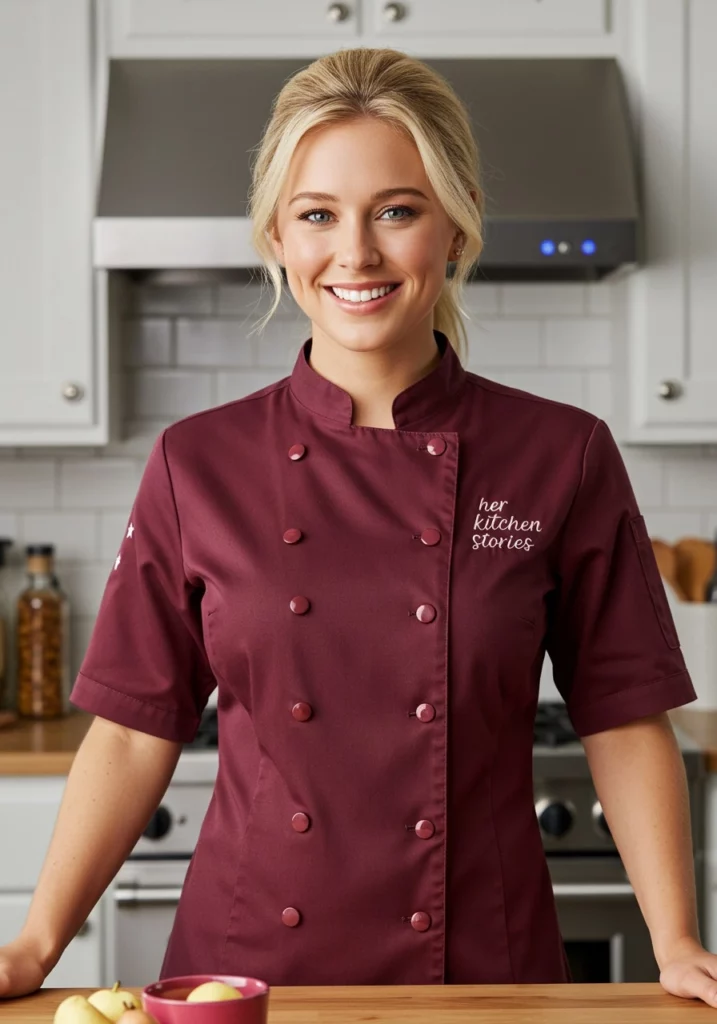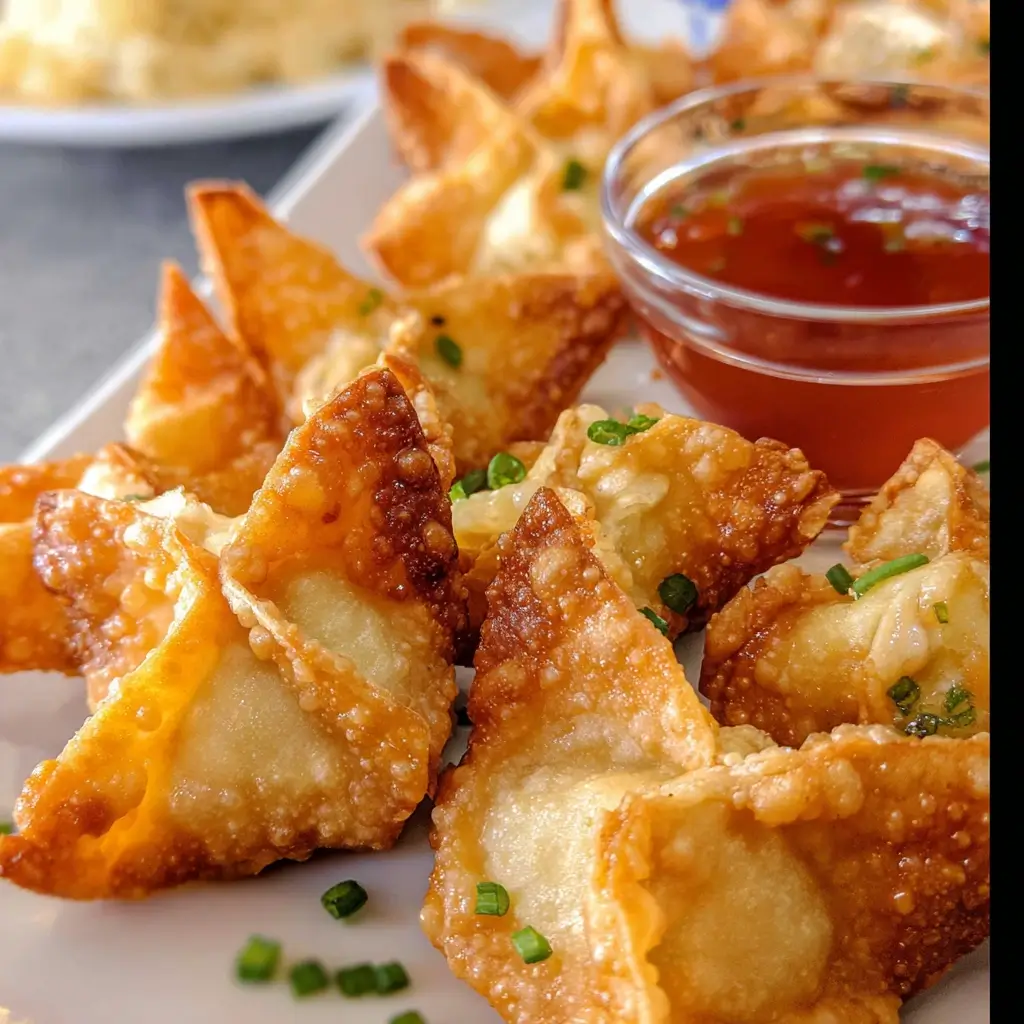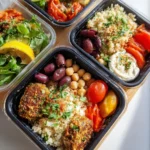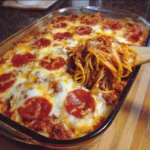There are few appetizers that elicit such universal delight as Crab Rangoon. For my family, these crispy, creamy, savory little parcels are more than just a starter; they’re a signal of a special occasion, a movie night treat, or simply a way to make an ordinary Tuesday feel extraordinary. I remember the first time I attempted to make them at home, convinced it would be an overly complicated affair. To my surprise, and immense satisfaction, they were not only manageable but also a resounding success. The kids, usually picky eaters, devoured them with gusto, their faces alight with joy at each crunchy bite giving way to that warm, luscious filling. My partner, a self-proclaimed Rangoon connoisseur, declared them “better than takeout.” That was high praise indeed, and since then, homemade Crab Rangoon has become a staple in our culinary repertoire. The beauty of this recipe lies in its simplicity, yielding results that taste incredibly gourmet. It’s the contrast of textures – the shatteringly crisp wonton shell against the smooth, slightly tangy, and umami-rich cream cheese and crab filling – that makes them so utterly addictive. This recipe is my tried-and-true version, perfected over many batches, and I’m thrilled to share it with you. Get ready to impress your friends, delight your family, and perhaps even find your new favorite go-to appetizer.
The Ultimate Homemade Crab Rangoon Recipe
This recipe aims for that perfect balance of creamy, savory, and subtly sweet, encased in a perfectly golden and crisp wonton wrapper. We’re using ingredients that are easy to find, ensuring you can whip these up whenever the craving strikes.
Ingredients: Crafting the Perfect Bite
Gathering your components is the first step to Rangoon bliss. Precision isn’t strictly necessary for some of the seasonings, so feel free to adjust slightly to your taste after an initial mix.
- For the Filling:
- 8 ounces (226g) full-fat cream cheese, softened to room temperature (this is crucial for a smooth filling)
- 6-8 ounces (170-226g) crab meat (canned, lump, or imitation crab, drained very well and flaked)
- 3-4 green onions (scallions), thinly sliced (both white and green parts)
- 1 tablespoon Worcestershire sauce
- 1 teaspoon soy sauce (low sodium recommended)
- 1/2 teaspoon garlic powder (or 1 small clove fresh garlic, minced very finely)
- 1/4 teaspoon white pepper (optional, but adds a traditional touch)
- 1/2 teaspoon granulated sugar (optional, balances the savouriness)
- Pinch of salt (taste filling before adding, as crab and soy sauce are salty)
- For Assembly & Frying:
- 1 package (approx. 40-50 count) square wonton wrappers
- Small bowl of water (for sealing the wontons)
- 3-4 cups neutral-flavored cooking oil with a high smoke point (e.g., canola, vegetable, peanut, or corn oil) for frying
- Optional for Serving:
- Sweet chili sauce
- Duck sauce
- Sweet and sour sauce
- Soy-ginger dipping sauce
Instructions: From Simple Ingredients to Crispy Perfection
Follow these steps carefully, and you’ll be rewarded with restaurant-quality Crab Rangoon right in your own kitchen. The process can be broken down into preparing the filling, assembling the Rangoons, and frying them to golden perfection.
Step 1: Prepare the Luscious Filling
- Soften Cream Cheese: Ensure your cream cheese is truly at room temperature. This is the secret to a lump-free, creamy filling. If you’re short on time, you can unwrap it and microwave it on a plate for 15-20 seconds, but be careful not to melt it.
- Combine Ingredients: In a medium-sized mixing bowl, add the softened cream cheese. Use a fork or a hand mixer on low speed to beat it until smooth and creamy.
- Add Crab and Aromatics: Add the well-drained and flaked crab meat, thinly sliced green onions, Worcestershire sauce, soy sauce, garlic powder, white pepper (if using), and sugar (if using) to the cream cheese.
- Mix Thoroughly: Gently fold and mix all the ingredients together until they are just combined. Overmixing can make the crab meat too stringy.
- Taste and Adjust: Taste a tiny bit of the filling. Adjust seasonings if necessary. You might want a little more Worcestershire for umami, or a pinch more sugar for balance. Add a tiny pinch of salt only if needed, as the crab and soy sauce contribute saltiness. Cover the bowl with plastic wrap and refrigerate for at least 15-30 minutes. This helps the flavors meld and makes the filling slightly firmer and easier to work with.
Step 2: Assemble the Crab Rangoons – The Art of the Fold
There are several ways to fold wontons for Rangoons. The traditional “purse” or “star” shape is popular, but a simple triangle also works well.
- Set Up Your Workstation: Lay out a few wonton wrappers on a clean, dry work surface (like a large cutting board). Keep the remaining wrappers covered with a damp paper towel or plastic wrap to prevent them from drying out. Have your small bowl of water and the chilled filling nearby.
- Place Filling: Place about 1 to 1.5 teaspoons of the crab filling into the center of each wonton wrapper. Be careful not to overfill, as this can cause them to burst during frying.
- Folding Technique (Classic Purse/Star Shape):
- Moisten all four edges of the wonton wrapper lightly with water using your fingertip.
- Bring two opposite corners up to meet in the center above the filling and pinch them together securely.
- Bring the other two opposite corners up to meet in the center, pinching them to the first two corners and along the sides to seal, forming a four-pointed star or a small purse. Ensure all edges are well-sealed to prevent the filling from leaking out during frying.
- Alternative Fold (Triangle):
- Moisten two adjacent edges of the wonton wrapper.
- Fold the wrapper diagonally to form a triangle, pressing out any air bubbles and sealing the edges firmly.
- Place Assembled Rangoons: As you fold each Rangoon, place it on a baking sheet lined with parchment paper, making sure they don’t touch (to prevent sticking). If you’re working in a dry environment, you can lightly cover the assembled Rangoons with plastic wrap or a slightly damp towel while you work on the rest.
Step 3: Fry to Golden, Crispy Perfection
- Heat the Oil: Pour the cooking oil into a heavy-bottomed pot, Dutch oven, or deep fryer. The oil should be at least 2 inches deep, preferably 3. Heat the oil over medium-high heat until it reaches a temperature of 350-375°F (175-190°C). Use a cooking thermometer for accuracy. If you don’t have a thermometer, you can test the oil by dropping a small piece of wonton wrapper into it. If it sizzles immediately and turns golden brown in about 30-45 seconds, the oil is ready. If it browns too quickly, the oil is too hot; if it sinks and absorbs oil without much sizzle, it’s too cool.
- Fry in Batches: Carefully place 4-6 Rangoons into the hot oil, being sure not to overcrowd the pot. Overcrowding will lower the oil temperature, resulting in greasy, soggy Rangoons.
- Cook Until Golden: Fry the Rangoons for about 2-4 minutes per side, or until they are beautifully golden brown and crispy. They will float to the surface as they cook. Use tongs or a spider-skimmer to gently turn them for even cooking.
- Drain Excess Oil: Once golden and crisp, remove the Rangoons from the oil using a slotted spoon or spider skimmer, allowing excess oil to drip back into the pot. Transfer them to a wire rack set over a baking sheet or a plate lined with paper towels to drain further. The wire rack helps keep the bottoms crispy.
- Repeat: Continue frying the remaining Rangoons in batches, ensuring the oil temperature returns to 350-375°F (175-190°C) between batches.
Step 4: Serve and Enjoy!
Serve the Crab Rangoons warm with your favorite dipping sauces on the side.
Nutrition Facts (Approximate)
- Servings: This recipe makes approximately 40-50 Crab Rangoons.
- Serving Size: Let’s consider a serving to be 4 Rangoons.
- Calories per serving (4 Rangoons): Approximately 300-380 calories.
Disclaimer: Nutritional information is an estimate and can vary significantly based on the exact ingredients used (especially the type of crab meat and amount of oil absorbed during frying), portion sizes, and specific cooking methods. Frying generally adds a considerable amount of fat and calories.
Preparation & Cook Time
Understanding the time commitment helps you plan your culinary adventure.
- Preparation Time:
- Mixing the filling: 10-15 minutes
- Chilling the filling: 15-30 minutes (minimum)
- Folding the Rangoons: 30-45 minutes (depending on your speed and desired shape complexity)
- Cook Time:
- Frying in batches: 20-30 minutes (approximately 3-5 minutes per batch)
- Total Estimated Time: Approximately 1 hour 15 minutes to 2 hours (including chilling time).
This time can be reduced if you have helping hands for the folding process, which can also be a fun group activity!
How to Serve Your Glorious Crab Rangoons
Serving Crab Rangoon is all about enhancing their inherent deliciousness and making them the star of the show, whether as an appetizer or part of a larger spread.
- As a Standalone Appetizer:
- Arrange them artfully on a platter.
- Provide a selection of dipping sauces in small bowls. Popular choices include:
- Sweet Chili Sauce: The classic pairing, offering a sweet, tangy, and slightly spicy counterpoint.
- Duck Sauce: A fruity, sweet, and tangy sauce common in American Chinese restaurants.
- Sweet and Sour Sauce: Another classic, with its vibrant red color and familiar tangy sweetness.
- Soy-Ginger Dipping Sauce: A simple mix of soy sauce, rice vinegar, a touch of sesame oil, grated ginger, and perhaps a pinch of sugar.
- Spicy Mayo: Mayonnaise mixed with sriracha and a squeeze of lime juice for a creamy, spicy kick.
- Garnish the platter with fresh cilantro sprigs, thinly sliced green onions, or a sprinkle of toasted sesame seeds for visual appeal and an extra layer of flavor.
- Part of an Asian-Inspired Feast:
- Serve Crab Rangoons as a starter before a main course of dishes like:
- Stir-fried noodles (Lo Mein, Pad Thai)
- Fried rice
- General Tso’s Chicken or Orange Chicken
- Beef and Broccoli
- Steamed or stir-fried vegetables
- They add a delightful crunchy and creamy element to a multi-course meal.
- Serve Crab Rangoons as a starter before a main course of dishes like:
- For Parties and Gatherings:
- Crab Rangoons are perfect finger food for parties.
- Make a large batch and keep them warm in a low oven (around 200°F or 93°C) on a wire rack until ready to serve. Don’t cover them tightly, or they’ll lose their crispness.
- Set up a “Rangoon Bar” with various dipping sauces for guests to choose from.
- Presentation Tips:
- Use a serving dish that allows air to circulate if possible, like a basket lined with decorative paper, to help maintain crispness.
- Don’t overcrowd the serving platter; it’s better to replenish it as needed.
- Serve them hot! Crab Rangoons are best enjoyed fresh from the fryer when they are at their crispiest.
Additional Tips for Crab Rangoon Supremacy
Elevate your Crab Rangoon game with these five essential tips, ensuring every batch is a triumph.
- The Crab Meat Matters (But Not Too Much!): While lump crab meat offers a superior texture, good quality canned crab meat (well-drained and flaked) or even finely chopped imitation crab (surimi) works surprisingly well and is more budget-friendly. The key is to drain it extremely well. Excess moisture in the crab meat will make your filling watery and can lead to soggy Rangoons or blowouts during frying. Pat it dry with paper towels after draining.
- Achieve the Perfect Seal: This is paramount to prevent the precious filling from oozing out into the hot oil, creating a mess and ruining your Rangoons. Use only a small amount of water on the edges – too much can make the wrapper gummy. Press firmly to seal, ensuring there are no air pockets near the seal. If you find your wrappers are drying out quickly, work with fewer at a time or keep them covered.
- Master Oil Temperature Control: This is the secret to crispy, not greasy, Rangoons. Invest in a deep-fry thermometer. If the oil is too cool (below 350°F/175°C), the Rangoons will absorb too much oil and become heavy and greasy. If it’s too hot (above 375°F/190°C), the wrappers will brown too quickly, potentially burning before the filling is heated through. Maintain the temperature range throughout the frying process, allowing the oil to recover heat between batches.
- Don’t Overcrowd the Fryer: Frying in small batches (typically 4-6 Rangoons at a time, depending on the size of your pot) is crucial. Adding too many Rangoons at once will significantly drop the oil temperature, leading to the dreaded soggy outcome. Give them space to float and cook evenly.
- Make-Ahead and Freezing Strategy:
- Uncooked Rangoons: You can assemble the Rangoons, place them in a single layer on a parchment-lined baking sheet, and freeze until solid. Once frozen, transfer them to a freezer-safe bag or container for up to 2-3 months. Fry directly from frozen, adding an extra minute or two to the cooking time. Do not thaw before frying.
- Cooked Rangoons: While best fresh, leftover cooked Rangoons can be stored in an airtight container in the refrigerator for 2-3 days. Reheat them in an oven or toaster oven at 350°F (175°C) for 5-10 minutes, or in an air fryer, until crispy and heated through. Avoid microwaving, as it will make them soft and chewy.
FAQ: Your Crab Rangoon Curiosities Answered
Here are answers to some frequently asked questions about making Crab Rangoon at home.
Q1: Can I use real crab meat instead of imitation? What’s the difference?
A: Absolutely! You can use fresh, frozen (thawed and well-drained), or canned lump crab meat. Real crab meat will provide a more delicate, authentic crab flavor and a flakier texture. If using canned real crab, be sure to pick through it carefully for any bits of shell or cartilage. Drain it exceptionally well. Imitation crab (surimi) is made from fish paste and flavored to mimic crab. It’s more economical and has a slightly sweeter taste and a more uniform, somewhat rubbery texture, which many people actually prefer in Rangoons for its distinct “takeout” vibe. The choice depends on your budget and flavor preference. Both work well in this recipe.
Q2: Can I bake Crab Rangoons instead of frying them for a healthier option?
A: Yes, you can bake them, but the texture will be different. They won’t be as uniformly golden or as shatteringly crisp as fried Rangoons; the wrappers tend to be a bit chewier with crispier edges. To bake:
1. Preheat your oven to 400°F (200°C).
2. Arrange the assembled Rangoons in a single layer on a baking sheet lined with parchment paper or lightly greased.
3. Lightly spray the tops of the Rangoons with cooking spray or brush them with a thin layer of melted butter or oil. This helps them brown and crisp up.
4. Bake for 10-15 minutes, or until the wrappers are golden brown and crispy, especially at the edges, and the filling is hot. You might want to flip them halfway through for more even browning.
Air frying is another excellent alternative that yields results closer to deep-frying. Air fry at around 375°F (190°C) for 6-10 minutes, shaking the basket halfway, until golden and crisp.
Q3: How do I store leftover Crab Rangoons, and what’s the best way to reheat them?
A: Let leftover Crab Rangoons cool completely to room temperature. Then, store them in an airtight container in the refrigerator for up to 2-3 days.
To reheat and restore crispness:
* Oven/Toaster Oven (Recommended): Preheat to 350°F (175°C). Place Rangoons in a single layer on a baking sheet and heat for 5-10 minutes, or until warmed through and crispy.
* Air Fryer (Excellent): Reheat at 350-375°F (175-190°C) for 3-5 minutes, or until crispy and hot.
Avoid reheating in the microwave, as this will make the wonton wrappers soft, steamy, and chewy.
Q4: Why are my Crab Rangoons bursting open when I fry them?
A: This is a common issue with a few potential culprits:
* Overfilling: Too much filling will expand during cooking and push its way out. Use only about 1 to 1.5 teaspoons per wrapper.
* Poor Seal: If the edges aren’t sealed tightly, the filling can leak. Ensure you moisten the edges adequately (but not too much) and press firmly, expelling any trapped air near the seal.
* Trapped Air: Large air pockets inside the wonton can expand and cause bursting. Try to press out air as you seal.
* Oil Temperature Too Low: If the oil isn’t hot enough, the Rangoons sit in it longer, and the wrapper can become saturated and weak before it crisps, making it more prone to bursting.
* Sudden Temperature Change: If using frozen Rangoons, ensure they are fully frozen. Partially thawed ones might behave unpredictably.
Q5: What’s the best type of oil for frying Crab Rangoons?
A: The best oils for frying Crab Rangoons are neutral-flavored oils with a high smoke point (the temperature at which the oil starts to break down and smoke). Good choices include:
* Canola Oil
* Vegetable Oil
* Peanut Oil (great flavor, but be mindful of allergies)
* Corn Oil
* Safflower Oil
* Grapeseed Oil
Avoid oils with low smoke points like extra virgin olive oil, as they will burn and impart an unpleasant flavor. You’ll need enough oil for the Rangoons to float freely, usually about 2-3 inches deep in your pot.





